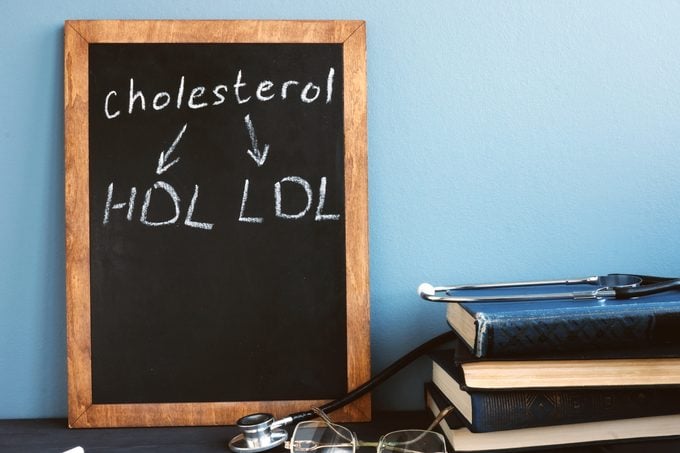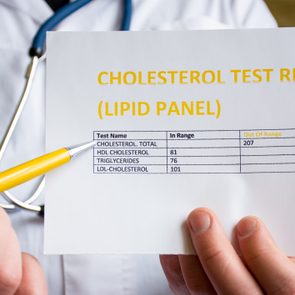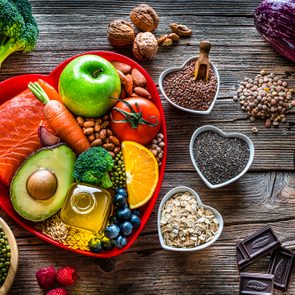HDL vs. LDL Cholesterol: What’s the Difference?
Updated: Feb. 01, 2022
Cholesterol gets a bad rap, but not all forms raise your risk for heart disease. Here's what to know about good cholesterol, bad cholesterol, and how to maintain target levels of HDL vs. LDL cholesterol.
Cholesterol and heart health
Ask anyone, and they’ll tell you cholesterol is that thing nobody wants. After all, it’s terrible for your health. Isn’t it?
Well, not exactly. This waxy, fat-like substance is the essential building block of all cells. It helps support cell walls and coats your nerves in a protective sheath.
Without cholesterol, sex hormones like estrogen, progesterone, and testosterone could not be produced. And your bones would weaken from a lack of vitamin D.
“Cholesterol serves as the backbone molecule to synthesize hormones and vitamins, which are essential for healthy bodily function,” says Jennifer Wellings, MD, a cardiologist with Englewood Health in New Jersey.
One type of cholesterol, high-density lipoprotein (HDL), actually boosts heart health.
But low-density lipoprotein (LDL), another type of cholesterol, can be damaging. In excess, it leads to plaque buildup in the walls of the arteries, including those of the heart.
High LDL cholesterol is a key factor in heart disease, primarily heart attacks. Globally, nearly 18.6 million people died in 2019 from heart disease, according to the American Heart Association.
They key to health is finding a balance in your HDL vs. LDL cholesterol levels.
“Just as your car needs oil, your heart and blood vessels need cholesterol,” says Christopher Di Giorgio, MD, a cardiologist also with Englewood Health. “Problems arise when the components of your cholesterol are not present in the right quantity and quality.”
A good starting point on your pathway to better health is understanding the difference between HDL and LDL cholesterol, from what they are and what they do to target levels and how to raise or lower yours.

HDL vs. LDL cholesterol
Your liver makes nearly all the cholesterol your body needs to effectively function. But an unhealthy diet, high in the unhealthy types of fat, can prompt the liver to produce even more cholesterol.
Pure cholesterol cannot mix with or dissolve in the blood (think of it like the whole oil-and-water scenario). So your liver packages cholesterol with proteins in carriers called lipoproteins, which transport cholesterol throughout the body.
There are two distinct types: high-density lipoproteins and low-density lipoproteins, so named for how dense the particle is. Although both are considered cholesterol, their roles are very different.
“Bad” cholesterol
LDL moves cholesterol through the blood to where it is needed for cell repair and other functions. Because these particles have more fat than protein—the latter of which is denser—they’re considered low-density lipoproteins.
Remember, your body produces nearly all the cholesterol it needs. When you eat a high-cholesterol diet, you end up with excess LDL in the blood.
All this extra LDL collects on artery walls, creating plaque and hardening the arteries, says Dr. Di Giorgio. Over time, this can lead to a serious disease called atherosclerosis.
Hence the nickname: “bad” cholesterol.
“Good” cholesterol
In contrast is HDL, which carries excess LDL cholesterol away from the arteries and back to the liver. There, the LDL is broken down and passed from the body.
That’s why it’s considered the “good” cholesterol.
But even the hardworking HDL cholesterol can’t completely eliminate all the extra LDL cholesterol. According to the American Heart Association (AHA), only one-third to one-fourth of blood cholesterol is carried by HDL.
Lowering your bad cholesterol levels even further is up to you, the medications you take, and the lifestyle changes you make.
Ideal cholesterol levels
According to the Centers for Diseases Control and Prevention (CDC), over a third of the U.S. population has high LDL cholesterol. Many of them probably are not even aware of the dangers—there are usually no signs of high cholesterol. That is, until a heart attack or stroke occurs.
The only way to know if you have high cholesterol is to get your level checked.
Your doctor can do a simple blood test, called a lipid profile or lipid panel, to measure your cholesterol levels. It detects the milligrams of cholesterol per deciliter of blood (mg/dl) in your system.
The following are desirable levels of LDL, HDL, total cholesterol, and triglycerides (another type of blood fat), according to the CDC:
- LDL cholesterol: less than 100 mg/dl
- HDL cholesterol: 60 mg/dl or higher
- Total cholesterol: less than 200 mg/dl
- Triglycerides: less than 150 mg/dl
High LDL, low HDL, and high triglycerides together is a dangerous trifecta for your heart health, according to Indu Poornima, MD, a cardiologist with Allegheny Health Network in Pittsburgh.
Causes of high LDL cholesterol
A propensity for high LDL cholesterol is sometimes inherited, says Vicki Knight-Mathis, MD, an Atlanta-based physician. For instance, a rare genetic condition known as familial hypercholesterolemia can cause very high LDL cholesterol levels beginning at a young age.
But generally speaking, cholesterol is tied more to what’s in your jeans than your genes. If you have a family history of obesity tied to diet and a sedentary lifestyle, says Dr. Poornima, you’ll likely share high cholesterol as well.
“The driving force [of high cholesterol] in the United States is lifestyle,” Dr. Knight-Mathis says. And big factors in an unhealthy lifestyle? An unhealthy diet, smoking, lack of exercise, and obesity.
The risk for high cholesterol also goes up with age, mainly because the body loses some of its natural efficiency to clear cholesterol from the blood.
Sex also plays a role, according to Dr. Poornima. Overall, women tend to have lower cholesterol, due in part to estrogen’s ability to boost good cholesterol. But when estrogen levels drop during menopause, women’s cholesterol rises.
How to lower LDL cholesterol
A diet loaded with trans and saturated fats is a major driver of high LDL cholesterol levels.
“Saturated fats, such as fat found in bacon, sausage, the skins or fat of poultry and meat, and fried or greasy foods, should be eaten in moderation,” advises Alicia Romano, a clinical dietitian at Tufts Medical Center in Boston.
The AHA recommends a diet containing less than 6 percent of daily calories from saturated fat.
So if you need about 2,000 calories a day, no more than 120 calories—or about 13 grams—should come from saturated fat. That’s about one tablespoon of butter.
Trans fats, the other unhealthy fat that hikes up your LDL level, are best avoided altogether.
But you can’t just cut out unhealthy fats and hope for the best. In addition to loading up on heart-healthy foods, you’ll also want to get more healthy fats from foods like olive oil, nuts, seeds, and fatty fish such as salmon.
Other ways to lower your LDL cholesterol include getting more exercise, quitting smoking, taking cholesterol-lowering medication, and losing weight.

How to raise HDL cholesterol
When levels of HDL cholesterol are too low (below 45 mg/dl in women and 40 mg/dl in men), your risk for atherosclerosis, heart attack, and stroke increase. Lowering the level of LDL will naturally boost good cholesterol if your HDL level is low.
“A person’s cholesterol is the result of genetic factors, which are not modifiable, and dietary and lifestyle factors which are,” says Dr. Di Giorgio.
So quitting smoking, adopting a heart-healthy diet, losing weight, and doing aerobic exercise all have positive effects on HDL as well.
HDL vs. LDL cholesterol treatments and medication
Even high levels of HDL and a healthy lifestyle may not protect you from the risks of high LDL cholesterol. Working to keep the body in balance is the goal, says Dr. Di Giorgio.
“Unfortunately, while a diet and exercise can help mitigate cholesterol issues for many, some people have a genetic predisposition to high cholesterol,” he says.
For those with stubbornly high LDL, medication may be necessary to reduce the amount of cholesterol being formed in the liver. These medications are referred to as statins and they’re the first-line treatment for high cholesterol.
If those don’t do the trick, there are many different types of non-statin medications that can be used by people who don’t respond to statins, according to the American Heart Association. Those include:
- Cholesterol absorption inhibitors, such as ezetimibe
- Bile acid sequestrants, which help the intestines get rid of cholesterol
- PCSK9 inhibitors, which are injectable drugs that lower LDL by targeting a protein on liver cells
- Adenosine triphosphate-citrate lyase (ACL) inhibitors, which block cholesterol production
- Fibrates, which can help lower triglycerides and, to a lesser extent, LDL cholesterol
- Niacin (nicotinic acid), a B vitamin that can have some side effects, including niacin flushing
- Omega-3 fatty acid ethyl esters, which are derived from fish oils
- Marine-derived omega-3 polyunsaturated fatty acids (PUFA), which lower triglycerides when used in large doses, but can cause side effects like increased bleeding
Currently there are no medications aimed specifically at raising HDL levels, although sometimes HDL cholesterol improves when you use certain meds to lower LDL cholesterol. On a whole, HDL is typically improved through healthy lifestyle.
In general, doctors will treat both HDL and LDL simultaneously since both types of cholesterol work together to keep the heart and body healthy.
“We address both [with] medications focused on treatment of high LDL and lifestyle changes as the only way to address the low HDL,” explains Dr. Poornima.
Managing your cholesterol levels means making choices that improve your overall health and fitness and forming healthier habits.
“I always suggest looking at thing as a whole-health approach,” says Romano, who is also a registered nutrition consultant. “We can all take small steps every day that will improve not only our cholesterol levels, but will improve our general health.”

















